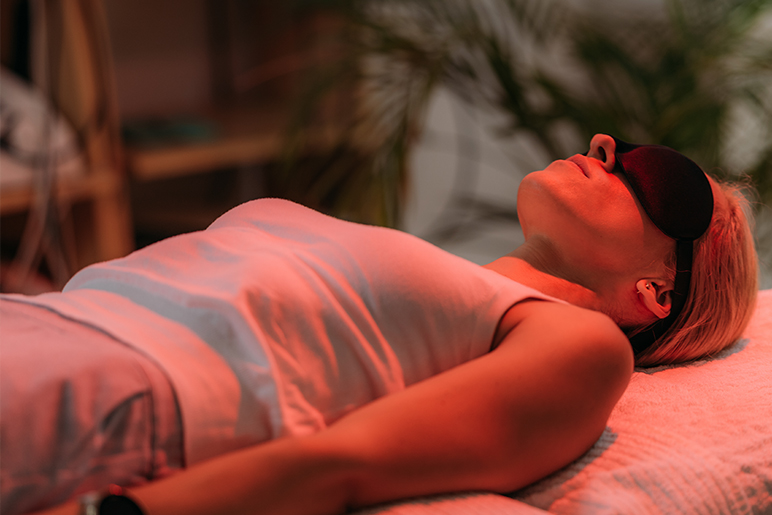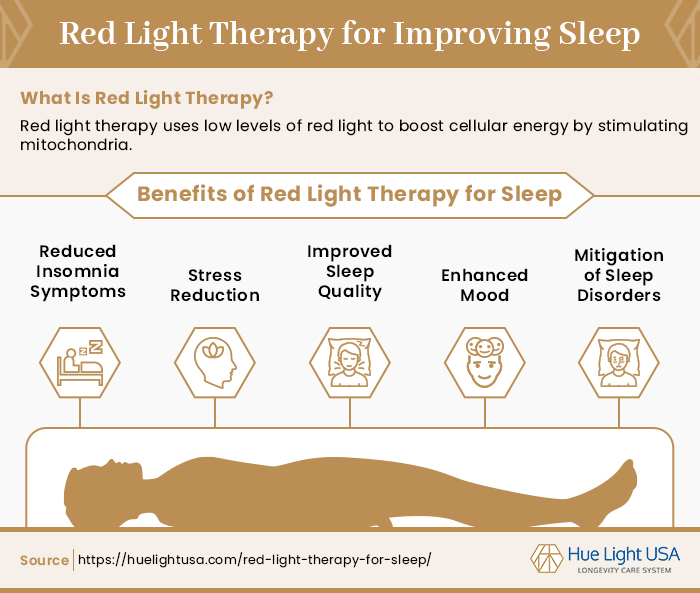
Is red light therapy the secret to better sleep?
You might have heard that claim. Red light therapy for sleep is gaining in popularity. It’s been talked about on CNN, and wellness influencers often describe red light therapy as a “sleep hack.”
But what does science say? Does red light therapy really promote better sleep?
In general, research is limited. But there is some evidence that, unlike blue light, red light doesn’t suppress melatonin. This is what keeps you up at night after staring at a screen.
In addition, some studies suggest red light helps with sleep disorders like jet lag and insomnia.
Ultimately, there isn’t strong evidence linking red light therapy and sleep quality. But that’s changing. More research is being conducted, and we continue to learn more about red light therapy’s impact on sleep.
Keep reading to learn what red light therapy is, why it’s believed to be a potential sleep aid, and how you can test it to get a better night’s sleep.
Red Light Therapy: A Brief Overview
Red light therapy, or photobiomodulation, is a therapeutic technique that exposes the body to low levels of red and near infrared light. Red light is believed to stimulate cell mitochondria, helping our cells generate more energy.
This lift in energy production stimulates a biochemical response that trigger a variety of positive health outcomes. Additionally, red light wavelengths penetrate deeper into the body offering relief from inflammation and pain.
Some of the positive benefits of red light therapy that may promote sleep include:
- Increase in blood flow. This can help to deliver oxygen and nutrients to tissues, which can promote healing.
- Reduced inflammation. This can help to relieve pain and swelling. Pain is a common reason for sleeplessness.
- Immune system boost. This could help to fight off infection and disease.
- Stress relief. RLT may reduce stress and lift mood, two common reasons for sleeplessness.
Does Red Light Help You Sleep?
The research on red light for sleep is mixed. However, there’s one important note to make: Red light therapy doesn’t disrupt melatonin secretion like blue light.
The retina in our eyes contains cells with are highly sensitive to blue light. When we stare at our screens before bed, these cells directly signal the brain to inhibit melatonin secretion. This is why screen time before bed can make it harder to fall asleep and stay asleep.
Red light doesn’t have this same interaction. In fact, some studies suggest the opposite is true; red light therapy may promote melatonin production.
For example, a 2012 study in the Journal of Athletic Training found that 30 minutes of RLT over a two-week period resulted in:
- Better sleep quality
- Higher melatonin levels
- Improved athletic endurance
However, the results are limited with only small studies.
Several studies have found contradictory evidence. For example, long-term exposure to red light (6 hours) may delay our sleep schedule by an hour. And others have found light therapy to have small-to-medium effects on sleep quality.
There is however a lot of anecdotal evidence that red light therapy supports sleep.
Anecdotally, many of our clients say it absolutely does. But for best results, use red light therapy along with sleep quality guidelines, like sticking to a schedule and physical activity. This can help to maximize the effectiveness of a red light bedtime routine.
Red Light Therapy and Sleep: Exploring the Science
The efficacy of red light therapy for sleep hasn’t been widely studied.
But a prevailing theory is that RLT’s effects (circulation, relaxation, and pain relief) may help induce sleepiness. Also, researchers are exploring red light’s ability to regulate melatonin production and circadian cycles.
Just one small study found that red light stimulated melatonin production. Others have explored red light for these sleep conditions:
Sleep Inertia
Sleep inertia refers to having difficulty waking up in the morning. One study found that using red light for those who just woke up helped to decrease sleepiness and improve morning performance.
Insomnia
A variety of studies have explored light therapy’s effect on insomnia. However, the majority of research relates to bright light therapy, which is different from red light therapy. Currently, this area is under study, but no relevant research has been published.
Circadian Rhythm
In a 2019 study, researchers exposed office workers to red light during the workday. They found that red light helped to regulate circadian rhythms, as well as limit the afternoon crash after lunch.
Light Therapy for Sleep: Key Benefits
Here are five potential benefits of red light therapy to help you get deeper sleep and to fall asleep more quickly:
1. Enhanced Sleep Quality
Early studies indicate that red light therapy before bed may lead to deeper, more restful sleep and reduced nighttime disturbances. This could be due to the combined effect of increased melatonin and relaxation.
2. Calming, Relaxation
Red light therapy is known to have calming effects, potentially reducing stress and anxiety that can interfere with sleep. This can create a more relaxed state conducive to falling and staying asleep.
3. Faster Recovery
Red light therapy’s cellular effects aid in expediting muscle recovery and reducing post-exercise soreness. When your body recovers more efficiently, it can contribute to an overall improvement in physical performance. This, in turn, can indirectly benefit your sleep by preventing discomfort or pain from interfering with your ability to rest soundly.
4. Mood Regulation
Sleep and mood share an intricate relationship. Disrupted or poor-quality sleep can lead to mood swings, increased anxiety, and even depression. Red light therapy can play a pivotal role in stabilizing your mood by reducing symptoms of anxiety and depression.
By creating a more serene mental state, it helps you enter a peaceful state of mind conducive to restful sleep. As a result, you’re more likely to wake up feeling refreshed and in a positive frame of mind.
5. User-Friendly, Convenient
Red light therapy can be performed at night as part of a relaxing bedtime routine. Consumer red light therapy pads and lamps, for example, may it easy to use RLT at home. Plus, RLT can often be combined with meditation or light yoga to further destress and prepare the body for rest.
Benefits of Red Light Therapy for Sleep

Risks of Red Light Therapy
While generally considered safe, it’s essential to be aware of potential risks of red light therapy and how they might apply to sleep-specific use.
Here’s a breakdown of the key points:
General Risks
- Eye Damage: Exposure to bright red light, especially at close range, can potentially damage the retina.
- Skin Burns: Overexposure or improper use can lead to burns, especially on sensitive skin.
- Headaches and Discomfort: Some individuals might experience temporary headaches or eye strain after treatment.
Additional Risks for Sleep Use
Red light is less disruptive than blue light. However, exposure too close to bedtime can still suppress melatonin production and delay sleep onset. Avoid using red light therapy right before bed.
How to Use Red Light Therapy for Sleep
Want to give it a try? First, it’s recommended that you consult your doctor. Tnen, set a baseline.
Track your sleep for a week prior to starting a red light therapy regimen. You can do this with a sleep diary or a sleep tracker device. Next, establish your red light routine:
- Duration and timing: Start with 10-20 minutes of red light exposure 3-5 times per week. Aim for about 1-2 hours before bedtime. (However, you may try earlier in the day, as well.) See our resource on how often you should use red light therapy.
- Location: Choose a relaxing, dimly lit environment where you can sit or lie comfortably.
- Activity: Try a relaxing activity during the session like reading, meditation or stretching. Avoid using devices that emit blue light.
Red light is safe for daily use. However, it’s recommended you limit the sessions to 20 minutes.
Tracking Results
Continue to track results during your red light sleep tests. A few areas to track include:
- Sleep tracking: Continue tracking your sleep throughout the trial, noting any changes in sleep quality, duration, or wakefulness. Look for improvements like falling asleep faster, sleeping more soundly, or waking up feeling more refreshed.
- Subjective feedback: Pay attention to your own perception of sleep. Do you feel more rested and energized during the day? Do you experience less nighttime anxiety or sleep-related disturbances?
- Duration of trial: Aim for at least 4 weeks of consistent red light therapy before evaluating its effectiveness. Some individuals may require longer periods to see noticeable results.
Conclusion
Red light therapy offers several wellness benefits. But will red light therapy help you sleep?
The answer to that question continues to be explored. Generally, research is limited. But there are many anecdotal reviews that sleep quality changes after using red light therapy.
If you’re interested in whether it will help you, the best course of action is to test it. Record your sleep patterns for one week, and then begin to incorporate red light therapy after you start. After starting, record your sleep quality, restfulness, sleep inertia, and ability to stay asleep.
This can help you determine if red light therapy’s a useful solution for you.
Give red light therapy a try. Hue Light USA is a leader, offering state-of-the-art red light therapy mats, pads and beds.


